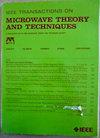A Gain Cell With Unilateralization and Gain-Enhancement Techniques for High-Gain Distributed Amplifier
IF 4.1
1区 工程技术
Q2 ENGINEERING, ELECTRICAL & ELECTRONIC
IEEE Transactions on Microwave Theory and Techniques
Pub Date : 2024-10-03
DOI:10.1109/TMTT.2024.3464638
引用次数: 0
Abstract
This article presents a novel circuit topology of gain cell for high-gain and broad-bandwidth distributed amplifier (DA). To enhance the gain with no deterioration in terms of bandwidth, no additional dc power dissipation and no increment of chip area, the unilateralization, interstage series-resonance, inductive-peaking, and current-reused techniques are incorporated dexterously into the proposed gain cell. The detailed analysis of gain enhancement and bandwidth improvement benefiting by the proposed gain cell is evaluated combined with simulation experiments. Experiments indicate that, by using the same process, the DA using the proposed gain cells achieves a gain improvement in excess of 8 dB larger than the DA using conventional gain cell without sacrificing the upper cutoff frequency, chip size, and dc power dissipation. Based on the theoretical analysis, a design methodology for high-gain DA is developed, and two single-stage DA prototypes, denoted by DA1 and DA2, are designed and implemented by using 0.25-采用单边化和增益增强技术的增益单元,适用于高增益分布式放大器
本文章由计算机程序翻译,如有差异,请以英文原文为准。
求助全文
约1分钟内获得全文
求助全文
来源期刊

IEEE Transactions on Microwave Theory and Techniques
工程技术-工程:电子与电气
CiteScore
8.60
自引率
18.60%
发文量
486
审稿时长
6 months
期刊介绍:
The IEEE Transactions on Microwave Theory and Techniques focuses on that part of engineering and theory associated with microwave/millimeter-wave components, devices, circuits, and systems involving the generation, modulation, demodulation, control, transmission, and detection of microwave signals. This includes scientific, technical, and industrial, activities. Microwave theory and techniques relates to electromagnetic waves usually in the frequency region between a few MHz and a THz; other spectral regions and wave types are included within the scope of the Society whenever basic microwave theory and techniques can yield useful results. Generally, this occurs in the theory of wave propagation in structures with dimensions comparable to a wavelength, and in the related techniques for analysis and design.
 求助内容:
求助内容: 应助结果提醒方式:
应助结果提醒方式:


